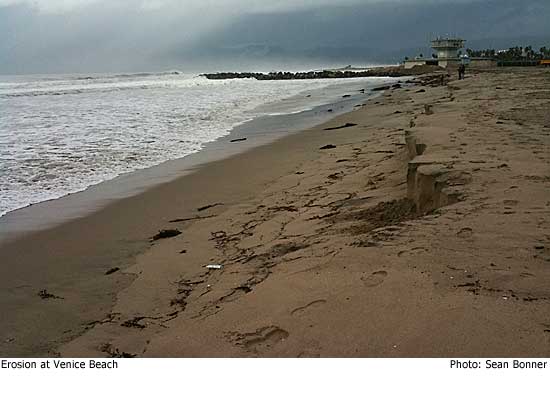The sandman cometh to Venice
October 12, 2010
On paper, it sounds almost boring: Move some sand across a beach. But when you’re talking about Venice Beach—L.A.’s seaside cradle of Beats and bodybuilders, celebrities and chainsaw jugglers—not even the sand wants to be ordinary.
So next month, engineers will be dodging just about everything from roosting birds to running grunions to random pipes and renegade sunbathers when the county’s long-awaited shore refurbishment gets underway.
The $1.66 million project, approved by the Board of Supervisors on Tuesday, will restore a section of beach around the landmark lifeguard headquarters that has been significantly eroded in recent years.
Since the construction of Venice’s breakwater in the early 1900s, the coast has been susceptible to erosion because the sand can’t be replenished by natural wave action. Over the decades, sections of beach have been periodically nourished, although fresh sand has not been added since the 1970s.
But the winter storms of 2004 and 2005 left the beach particularly damaged, and the wind and waves chewed it up again last winter. As a result, the renowned attraction was reduced to a dispiriting shadow of its famous old self, and local beachgoers couldn’t help but mourn the estimated 30,000 cubic feet of sand that disappeared.
The refurbishment will restore a segment of beach about the size of two city blocks where the public parking lot, recreational facilities and lifeguard headquarters are located.
“At first glance, it’s a very simple project,” said Department of Public Works Project Manager Sam Shadab. “But the devil is in the details.”
Dry sand will be hauled a half-mile or so into the eroded area from a 2,500-foot-long stretch of better-stocked beaches north of the breakwater. A convoy of massive earth-moving equipment will scoop two or three feet of surplus sand from the “borrow” area’s surface, then transport it in 10- or 20-cubic-yard loads to the eroded area.
 Each borrow site, Shadab said, will be barricaded with safety fencing to protect the public from construction activity. Public access to the water will be limited during construction to small openings in the barricades every 150 feet or so.
Each borrow site, Shadab said, will be barricaded with safety fencing to protect the public from construction activity. Public access to the water will be limited during construction to small openings in the barricades every 150 feet or so.
Each load, Shadab said, will be spread over the new site to smooth the beach and cover the exposed stone facing in front of the lifeguard building. The project should take only six to eight weeks, he added – a good thing “because we have a very small window of time.”
Why the limitations? Shadab and Public Works Section Head Kamel Youssef chuckle as they tick off the complications engineers will face.
“Well, we cannot operate the equipment on nights or weekends,” explained Youssef, who is overseeing the project. “And we cannot have construction from May to September, because that is beach season.”
“Then,” Shadab added, “we have the roosting season of the Snowy Plover. And we have to avoid the running of those little fish that look like snakes – the grunion. And we have to be cognizant of the California Brown Pelican and the California Least Tern, and make sure they have not returned late in the season.”
And then there’s the human wildlife, Youssef added.
“Some of this equipment weighs 20 tons with a 20 cubic yard capacity and a cockpit 10 or 12 feet off the ground,” he noted. “The wheels are as big as a man. The operators cannot see everything like you can see in your vehicle. So we have to have an extensive and detailed security system, and pilot cars in front of the convoy so that people don’t get run over. Some people, as you know, sleep in the sand.”
Then there’s the 66-inch drainage pipe that movers will have to avoid crushing, a challenge engineers plan to meet with a temporary “bridge” of reinforced concrete. And yet, Youssef and Shadab said, the strategy is still cheaper and less complicated than hauling in inland sand that might have damaged roads in other municipalities, widened the project’s carbon footprint and threatened the beach’s ecosystem.
The project, Youssef said, should be completed in January – one last obstacle permitting.
“If we have a lot of storms and rain,” he noted, “the equipment might sink into the sand.”
Posted 10/12/10













 405 bridge work causes a stink
405 bridge work causes a stink
